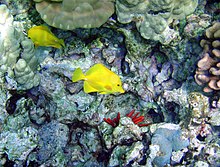Yellow tang
| Yellow Tang | |
|---|---|

| |
| Scientific classification | |
| Kingdom: | |
| Phylum: | |
| Class: | |
| Order: | |
| Suborder: | |
| Family: | |
| Genus: | |
| Species: | Z. flavescens
|
| Binomial name | |
| Zebrasoma flavescens | |
The yellow tang (Zebrasoma flavescens), also called naughty tang, is a saltwater fish species of the family Acanthuridae. It is one of the most popular aquarium fish.
Appearance
Yellow tangs are in the surgeonfish family. Adult fish can grow to 18 centimeters (approximately 6 to 7 inches) in length, and 1 to 2 centimeters (roughly .5 to .75 inches) in thickness. Males tend to be slightly smaller than females. All individuals of this species are bright daffodil yellow in color. At night, the yellow colouring fades slightly and a prominent brownish patch develops in the middle with a horizontal white band. They rapidly resume their solid bright yellow color with daylight.
They have an arrow-like shape due to their dorsal and ventral fins being almost an extension to their bodies, and a long snout-like mouth used (as with other tangs) to eat the algae off rocks and coral. They also have a sharp spine located near their tail. They are almost fully herbivores, and have become a popular fish for marine aquarists of all skill levels, as the fish tends to be active, hardy, and nonaggressive when kept with dissimilar species.
Food
Wild grasses, algae, caulerpa and other plant life in general. The yellow tang can also be found eating shrimp and other smaller animals and readily adapts to meat/fish based aquarium food. In the wild, shoals of Yellow Tang will provide cleaner services (into adulthood) to larger fish and turtles, by removing algal growth and dead tissue.
They are also attracted to bright and shiny things and may attack them in some cases - one excellent mothod of trapping Tangs is to use a mirror at the back of a trap instead of bait, capitalising on the animal's natural territorial aggression.
Distribution and habitats

It is commonly found in shallow reefs, from 2 to 46 m deep, in the Pacific and Indian Oceans, west of Hawaii and east of Japan.
In the Aquarium
The yellow tang is a very commonly kept as a saltwater aquarium fish. They can grow up to 8", although 6" is more common in noncaptivity. They require an aquarium of at least 80 gallons, while 150+ gallons is even better. They are herbivores, and are relatively easy to feed. They are usually very hardy, although, like all Tangs, are quite susceptible to Ich and other common saltwater diseases. They are semi-aggressive fish. They normally get along fine with other semi-aggressive fish close to their own size. Can be kept very well with other yellow tangs in pairs or in a group in large Tanks (150+ gallons). Possible other tankmates include fish like cardinalfish, large clownfish, lionfish, eels, or other different-looking Tangs like the blue tang or Achilles tang. They are reef-safe, and can be kept with any invertebrates in a reef aquarium.

Trivia
- In the film Finding Nemo the character Bubbles is a yellow tang.
- Yellow tangs are Hawaii's largest marine fish export, and one of the most popular fish in the U.S.
- Yellow tangs are one of the viewable fish in Nintendo's Endless Ocean for the Wii.
- Gregg "Opie" Hughes from the popular Opie and Anthony radio show has on several occasions expressed fear and loathing for yellow tangs, which nipped him unmercifully during a scuba excursion.
References
- Froese, Rainer; Pauly, Daniel (eds.). "Zebrasoma flavescens". FishBase. November 2005 version.
- "Zebrasoma flavescens". Integrated Taxonomic Information System. 6 February.
{{cite web}}: Check date values in:|date=and|year=/|date=mismatch (help)
External links
- AquariumDomain Complete Resource for the Marine Aquarium Hobbyist.
